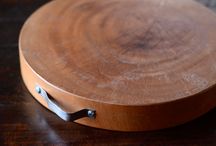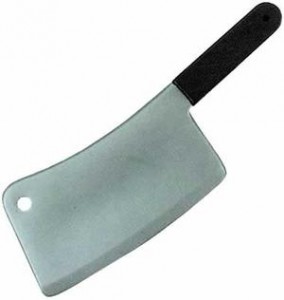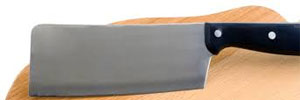Using cleaver and chopping board
China’s characteristic knife, the cleaver, may well seem like a lethal guillotine to the uninitiated, but it is surprisingly easy to
use. Its versatility as chopper, slicer, crusher, tenderizer and scooper effectively eliminates the need for a battery of knives in the kitchen. With care, a cleaver lasts more than a lifetime, and in China (as well as countries such as Singapore, Indonesia and Malaysia, where it is also used) the family knife is often passed on to the next generation, to continue its service as a culinary stalwart.
 Chopping Board
Chopping Board
Chinese people traditionally use a block of natural hardwood that is a complete round cut from a whole tree trunk, rather than several pieces of wood fused together, as is the case with many chopping boards today. The furious chopping action of the heavy Chinese cleaver will inevitably chip a synthetic board, but natural wood can absorb the blows without splintering. Cleaning such boards can be a problem. Chinese chefs use their cleavers to scrape off any bits of embedded food to prevent contamination. As a result, the boards become slightly concave over time.
 Cleavers
Cleavers
Heavier than most other knives, the cleaver is honed to razor sharpness and balanced to give the leverage needed to cut through joints of meat and even bone. There are several sizes and weights of cleaver, made from a variety of materials. They may have wooden or plastic handles, or be cast from a single piece of metal. While modern stainless-steel models produced by Western manufacturers can look impressive, they do tend to require frequent sharpening, as do the old-fashioned iron knives sold in Chinese supermarkets and Asian grocers. A far better choice is carbonized steel, which should always be wiped rather than washed after use, to prevent discoloration, then given a light coating of vegetable oil to prevent rusting.
